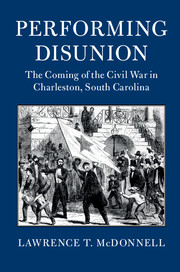16 - One of the B'hoys
from CRISIS: FIRE AND SWORD
Published online by Cambridge University Press: 08 June 2018
Summary
For a terrifying moment in the spring of 1855, everything Charlestonians most feared seemed poised to destroy them, striking from without and within. Mid- March, from the Neck to the Battery, the city was shrouded in dense, churning smoke. Enormous fires raged in the parched pine lands beyond the Upper Wards, cutting rail traffic and telegraph communication. “We are breathing smoke, eating smoke, sleeping smoke, and choking with smoke,” the Mercury reported, “and almost begin to fancy that life with us will fairly end in smoke.” Those nearby blazes were only a small part of a vast inferno, driven by gale- force winds, that seemed to be burning up the state altogether. From Edgefield to Newberry to Marion to Chesterfield Districts, one enormous conflagration turned churches, villages, and plantations to flame and ash. How long could coastal winds keep catastrophe from sweeping into Charleston? One good gust in the wrong direction, and the slaveholders’ citadel would reap the whirlwind of its deepest fears.
Almost 1,000 men, white and black, waited on that looming crisis, even as they fought desperate, smaller battles. A lumberyard fire sent $10,000 up in smoke; a bucket factory in Mount Pleasant, a casting shop on the East Bay, a downtown smithery all burned; kitchens, stables, and private dwellings erupted in flames; even a chimney next door to the Vigilant Fire Company's hall took light. The Mary Street railroad depot, full of cotton awaiting transshipment, posed a special hazard: fifty bales burned on the 24th, 100 more a week later. The Medical College and two hotels only narrowly avoided destruction. In each crisis, the crews of Charleston's thirteen white volunteer companies and the ten city engines staffed by slave and free black crews went “quickly at their work,” regardless of personal safety. It was not an especially busy month, and in many cases insurance covered much of the damage. Still, all knew that a single slip might mean disaster. “Extensive conflagration[s] “ struck St. Mary's and Sandersville, Georgia, in March, and major fires in Philadelphia and Pittsburgh drove home the need for vigilance and daring. The courage of Charleston's “gallant firemen” was tested on almost a daily basis.
- Type
- Chapter
- Information
- Performing DisunionThe Coming of the Civil War in Charleston, South Carolina, pp. 325 - 340Publisher: Cambridge University PressPrint publication year: 2018



